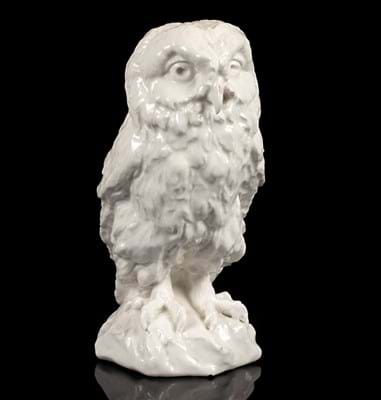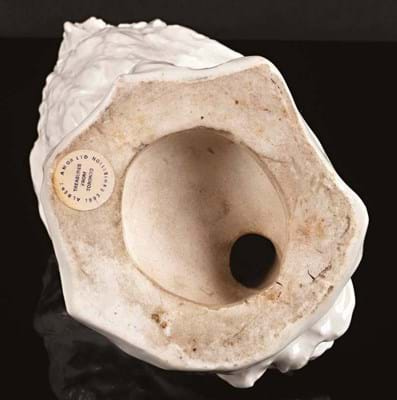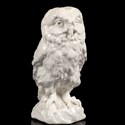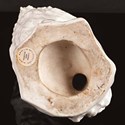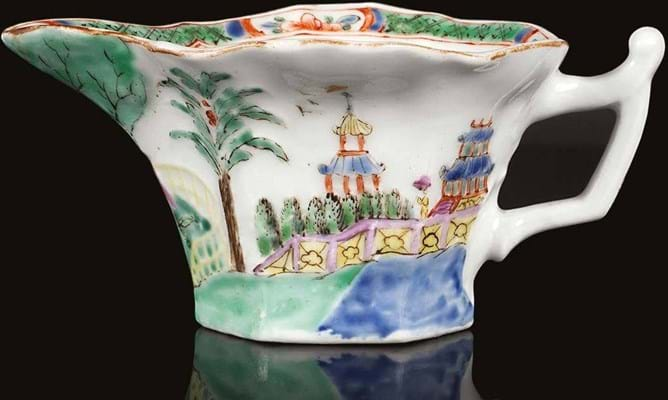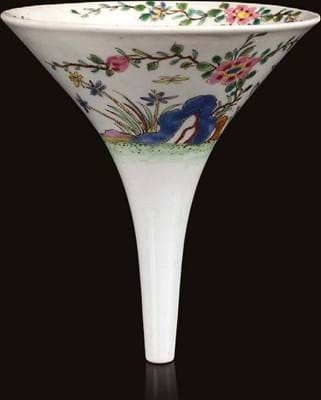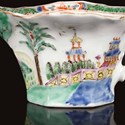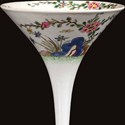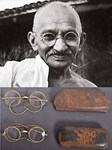The 18 pieces, chosen by the vendor’s late husband for rarity, early dates and condition, had been acquired in London between 1984-93, predominantly through the dealership Albert Amor.
Foremost was a Chelsea owl from the Triangle- Raised Anchor period c.1745-49.
This 8in (20.5cm) high model, long admired for its remarkable ornithological accuracy, is thought to be based on the plate of The Great Hawk or Horned Owl that appears in George Edwards’ A Natural History of Uncommon Birds, and of Some Other Rare and Undescribed Animals published between 1743-51.
Related models of owls on rocky bases are also found in Staffordshire saltglaze stoneware and in porcelain at Bow.
A number of these have appeared at auction in recent memory (and others offered within the trade) including the damaged example sold for £11,000 at Bonhams in 2018. Another sold for £22,000 at Bonhams in 2010 and a third took £19,000 at Woolley & Wallis in 2005 (the vendor had bought two in a box lot at a sale in Chichester).
Chorley’s owl had been acquired at Amor’s Treasures from Toronto exhibition in April 1993. It was in relatively good condition with only a shallow chip to the beak and two small glaze chips to the base to count against it.
Estimated at £15,000-20,000, it was chased by four bidders over £30,000 before it came down to a final tussle between an online bidder using the Chorley’s Live platform and a phone. It sold to the former, a UK private collector, at £40,000 (plus 22.5% buyer’s premium).
Early Worcester
A dozen coloured pieces from the very first years of the Worcester factory were topped at £12,000 by a relief-moulded hexagonal form creamboat c.1752-53.
Known as the Wigornia type (after the example with a moulded mark in the Dyson & Perrins Museum), the decoration is carefully picked out in a distinctive pale palette of yellow, blue, puce and green.
Sold at Sotheby Parke Bernet in New York in 1973, it was acquired from Amor in 1986.
Four coloured Wigornia creamboats of different designs have been sold by Bonhams in recent years, including the similar example in the Selwyn Parkinson collection (£16,000 in May 2016).
Wine funnels are a form unique to Worcester and, with a brief production period from c.1754-56, are prized rarities. Only 14 polychrome examples are known – the example here, in perfect condition with bright famille rose enamels, selling to a collector at £11,000 (estimate £10,000-15,000). It had been exhibited at Albert Amor as part of the Cohen collection in 1992.
A blue and white funnel from this period (others were made c.1770) sold for £10,000 at Tamlyns in July 2013, the same sum bid for a polychrome funnel with a Long Eliza figure as part of the Barratt collection of Crowe Hall, Bath, at Christie’s in 2010.


